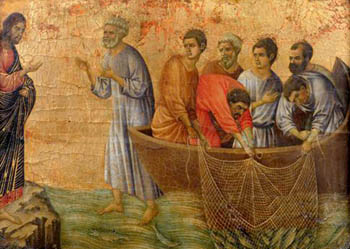Today on Fr. Mike Schmitz “Bible in a Year” podcast, Jeff Cavins in an introduction to the Gospel of John was talking about John 21:11
“So Simon Peter went aboard and hauled the net ashore, full of large fish, 153 of them.”
He was explaining that the number 153 is the numerical total for the Hebrew phrase Ani Elohim, which means “I am God”.
The Church Fathers had a range of opinions on the significance of 153 since it seems an odd number for John to mention (Plus it is an odd number).
St. Jerome said that at the time there were 153 known species of fish according to Oppian’s Halieutica. This was written after the Gospel of John and does not even clearly provide such a list adding up to that number.
St. Augustine had a couple of interpretations. Focusing on seven apostles being present or the seven gifts of the Holy Spirit along with the Ten Commandments. Some inventive theological math – see Tractates on the Gospel of John (Augustine). Also noting that 153 is the sum of all the numbers from 1 to 17. He also has several more mystical interpretations.
St. Gregory the Great mentions that Seven and ten multiplied by three make fifty-one. So multiply that by 3.
My theory is that St. John was trolling future commentators by picking that number. Well, that is not really my theory, but there is just no really solid one.
What annoyed me with the talk about this on the podcast was how the Gematria technique of interpretation was presented. It would have been better to present it as a possible interpretation and not as “the” interpretation. I happen to like this interpretation especially with the high Christology of the Gospel of John.
This podcast follows Jeff Cavins timeline and they are at the point where they will be reading the Gospel of John and thus today’s introduction to this Gospel. Coincidentally today’s Gospel included this specific passage, which I don’t think was planned.
Some selections from St. Thomas Aquinas’ “Catena Aurea: Commentary on the Gospel of John”:
St. Augustine. (Tract. cxxii.) It is not then signified that only a hundred and fifty-three saints are to rise again to eternal life, but this number represents all who partake of the grace of the Holy Spirit: which number too contains three fifties, and three over, with reference to the mystery of the Trinity. And the number fifty is made up of seven sevens, and one in addition, signifying that those sevens are one. That they were great fishes too, is not without meaning. For when our Lord says, I came not to destroy the law, but to fulfil, by giving, that is, the Holy Spirit through Whom the law can be fulfilled, He says almost immediately after, Whosoever shall do and teach them, the same shall be called great in the kingdom of heaven. In the first draught the net was broken, to signify schisms; but here to shew that in that perfect peace of the blessed there would be no schisms, the Evangelist continues: And for all they were so great, yet was not the net broken; as if alluding to the case before, in which it was broken, and making a favourable comparison.
St. Gregory. (Hom. xxiv.) Seven and ten multiplied by three make fifty-one. The fiftieth year was a year of rest to the whole people from all their work. In unity is true rest; for where division is, true rest cannot be.
St. Augustine. (Tract. cxxii.) Mystically, in the draught of fishes He signified the mystery of the Church, such as it will be at the final resurrection of the dead. And to make this clearer, it is put near the end of the book. The number seven, which is the number of the disciples who were fishing, signifies the end of time; for time is counted by periods of seven days


1 comment
Nice article. Thanks. St. Augustine seems to have the gist of the matter.
From the Shematria Gematria Calculator:
Ιχθυων + μεγαλων + δικτυον + γην + 153 = 777
[Translation: Fish + Large + Net + Land + 153 = 777]
https://shematria.pythonanywhere.com/index?source=777